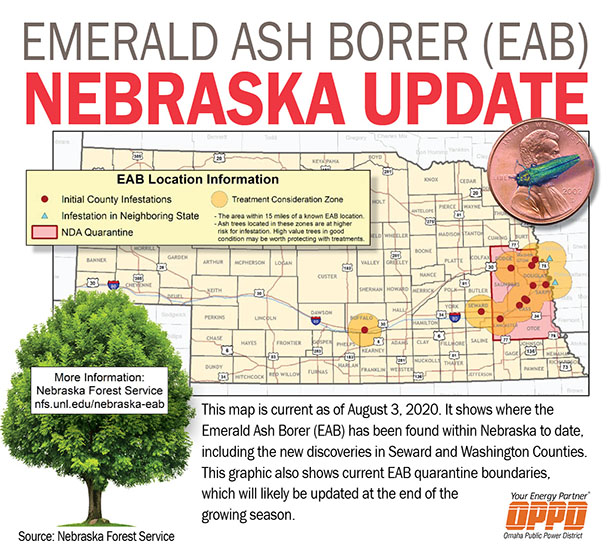
We haven’t heard as much about the threat of the emerald ash borer (EAB) lately, with attention focused on bigger headlines like the COVID-19 pandemic. But it remains a growing threat to ash trees in our area.
The emerald ash borer (EAB) is a tiny beetle that can create big damage to trees. The Nebraska Department of Agriculture recently announced three new EAB finds in the state. Last month, the department found infested trees in Blair and Kennard, both in Washington County. And an adult EAB was recovered from a trap in Seward in Seward County. They are the first discoveries within these counties, indicating the pest is expanding its territory.
EAB originated in Asia. It was first identified in the United States in the summer of 2002, when ash trees in Detroit became infested. In June of 2016, inspectors discovered the bug in Omaha’s Pulaski Park, and Nebraska became the 27th state to confirm the presence of EAB. As of June 2020, it is known to be in 35 states and the District of Columbia.
Fast mover
Infestations move through areas quickly, typically destroying about 70% of ash trees in their path within four years of initial discovery. That’s not only a threat to the landscaping and community tree canopy, but also to electric service.
Emerald ash borer larvae bore into the tissue under the bark. This weakens a dead or dying tree and makes them prone to breakage at the base, Norris said. If those trees are near power lines, they can cause damage to the electric system.
“And it’s a serious safety issue, as well,” Norris said. “We don’t want anybody getting hurt.”
Take action
Efforts by the City of Omaha and the State of Nebraska, among other entities, as well as individual customers over the past several years have helped ‘flatten the curve’ of EAB.
“But the insect is still present,” Norris said, “And it will continue to impact our ash population.”
He urged property owners to take action sooner rather than later if they have ash trees that are infested or in declining health, making them more vulnerable to infestation. “They should seriously make plans to remove the tree before it declines further. As ash trees die, they become more dangerous,” Norris said. “And that added risk drives up the cost of removal.”
There are ongoing treatments that can helpprevent healthy trees from becoming infested. Treatments should only be considered if EAB has been discovered within 15 miles. A certified arborist can help determine a good course of action for property owners.
“Any treatments people may be considering should not be done until early next spring, or when that particular treatment type warrants,” Norris said.
But fall is a great time to plant new trees. He reminded homeowners to always call 811 before digging. And to always be aware of overhead power lines.
Visit oppd.com/trees for more information on planting the right tree in the right place to avoid interference with electric equipment.
For more information on emerald ash borer, visit Nebraska’s EAB Resource Center website, hosted by Nebraska Forest Service.

Jodi Baker contributes stories to The Wire in addition to serving as a media liaison for OPPD. She was a reporter, working for news stations from her hometown of Omaha to San Diego, prior to joining the utility in 2013. Jodi has a bachelor’s degree in Broadcasting from the University of Nebraska-Omaha, with a minor in Criminal Justice. She’s married with two older children and two younger dogs – Shi Tzu mixes. She loves watching her daughter’s track meets, going to concerts with her husband Dave, who used to co-host a local music video program, and traveling whenever possible.
View all posts by Jodi Baker >






